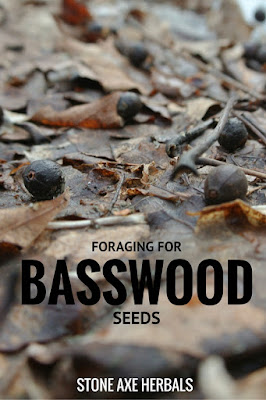10 Uses For Basswood Trees
The other day, I was walking in the woods in one of my all time favorite hiking spots and I looked down and found one of these (except there were seeds attached to the bottom):
It appeared to be some sort of samara from a tree but I had no clue which tree it was from. It seemed to have a similar purpose as a maple samara (aka helicopter), but it was very different and much larger. After a quick google search, I found that it was from a lime tree. Wait, what?! A lime tree in the middle of the woods in Northern Vermont, in the winter? That couldn't be right. And it wasn't, after just a bit more searching I realize that it was indeed from the lime family, but it was not a lime tree but a basswood, known as a linden in Europe, and as Tilia americana in the scientific world.
Then, the next thought I had was, as with most things, hm, I wonder if I can eat it? And it turns out that you can! So I went back a few days ago to see if I could find more and if I could, in fact, eat them. Well, I found quite a lot more, not so many of the samaras, but the individual seeds themselves.
It took me awhile but I eventually gathered a couple of handfuls of these seeds. The ones pictured above look dark brown-ish black, but when they are dry they look light green and almost fuzzy. I popped a few in my mouth, they were pretty chewy, but tasted pretty darn good, like walnuts almost.
What you see in the picture above is actually the seed casing. It is semi-soft, like a walnut hull, and are easy to crack open with your teeth to get at the seed inside. I sometimes just pop them in my mouth and eat the whole thing, though. While basswood seeds may not be the most viable survival food (they're pretty small and can take a long time to collect), they are definitely a fun trail snack. You can pick them up and eat them as you go and they take a while to eat so it can give you something to do while hiking. I could see kids really liking to find and eat these, it is very amusing to crack open the hulls and dig out the seeds with your teeth. Just don't confuse them with something else I found that day:
That's not a basswood seed, it's snowshoe hare poop! I still picked it up anyways, to find out why, check out my post on Making Pine Pitch Glue.
Although basswood seeds are a great snack for us, they are also loved and relied upon by many different animals. Many small birds and mammals eat these seeds, which can be found all winter. Basswoods are also important cavity trees for animals including woodpeckers, wood ducks, flying squirrels, and even owls to nest in. When most people think of cavity trees, they think of old gnarled maples or oaks full of rot, broken branch, and holes to hide in, but because the wood of the basswood tree is so soft, it is very easy for woodpeckers to carve out holes even in young, living trees. For this reason, basswood is also a highly valued tree among woodcarvers. When I went to his home and workshop several years back with Jordan at Rabbit Ridge Farm, Dave Brown, a local bowl turner told us that basswood is his all time favorite wood to work with.
Local bowl turner, Dave Brown, showing us how he makes his beautiful wooden bowls.
Then, I began to think about it, and I realized that I had used basswood before too! I didn't use it for carving, though, I had used fiber from the tree's inner bark to make cordage. The bark can be peeled from the tree and soaked for months, at which time the inner bark can be peeled off in strips and twisted into extremely strong and uniform cordage.
I've never tried this but I've heard that basswood cambium is also edible, and although it is fairly thin for most of the year, if you get it at the right time, around June, it is much thicker. If you find a basswood tree that has been cut down at this time of the year (it's not worth it to cut the whole tree just for the cambium, but it's great if the tree is already cut), you can scrape it off into strips and it is said to look like sauerkraut but taste like cucumbers.
Now, I've never tried this either, but I cannot wait for the basswood flowers to start coming out, because I have heard that if you pick some basswood flowers and maybe some of the fruit before it hardens, you can mash them into a paste. This paste apparently tastes exactly like chocolate! Who knew? Chocolate substitute isn't the only use for basswood flowers, though. Bees love basswood flowers and basswood honey is highly sought after!
Disclaimer: This blog is just my own opinion, nothing more. While I try my hardest, everything may not be completely accurate or complete. Sorry, I'm only human, so do not hold me accountable for anything you do to harm yourself or the world around you. I do make money from this blog (seriously not very much at all guys). If you click on any of the links in my blog I may make money from it. I'm not sponsored by any of these people I just honestly love these products and want to give you the resources to find them. I am not a medical practitioner; consult a health professional before using any herbal remedies. I am not claiming to diagnose, treat, prevent, or cure any ailment.







